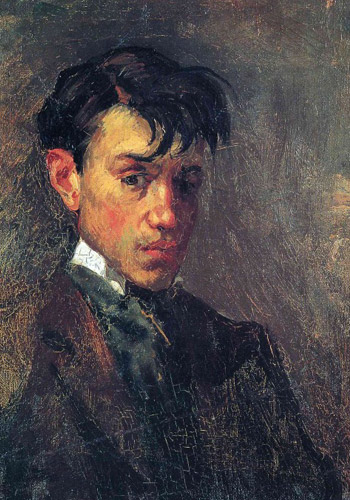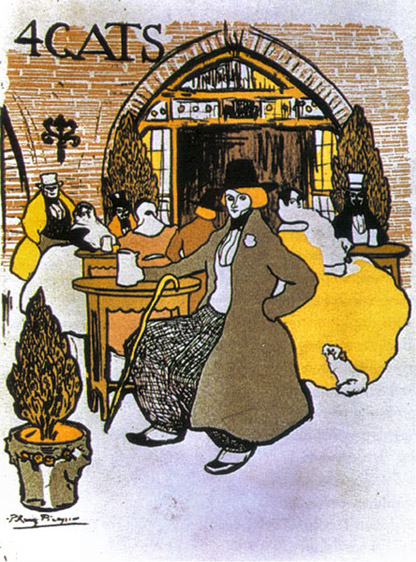Tube paints provide the freedom to paint out-of-doors, formerly, painters mixed pigment in their studios. This no fuss no muss ability is revolutionary to the world of painting; it is the catalyst announcing Modern Art, and the passing of the Renaissance era. A distinctive style and a new technique of painting is born. Beginning with Monet, successive paintings, in this collection, illustrate change and the differences between Modern and Renaissance painters. The London based, Winsor-Newton Company invented and manufacture tube paints. This image is of their first tube paints, 1840 - 1911.
Pablo Picasso (1881 - 1973) is born in Malaga, Spain. His dad, who happens to be an art teacher, quickly recognizes his son’s talent and eagerly guides Pablo’s early, art education. For inspiration, Picasso quits the Royal Academy in Madrid to copy the styles of the old masters in del Prado, the national art museum, nearby.
In Paris, Picasso is befriended by American born Gertrude Stein, a writer and American art collector. She becomes his patron and introduces him to a like-minded circle who meet regularly in the apartment she shares with her brother, Leo. Bullfights and the camaraderie of old friends in Spain are pleasant interludes; although, Paris becomes his adopted home.
The Modern Age, Renaissance man says he is not known for a particular style because he likes to reinvent his art. Picasso’s collective work includes: traditional classic painting, blue and rose periods, African-influenced tribal masks you see here - in his brief primitive period, and the pottery and sculpture he produces just for fun.
Many in the Western world of art believe the 20th century genius is best known for his Cubist paintings like The Young Women of d’Avignon.

Expressionist Primitive movement (1940s – 1950s) Picasso’s new inspiration is the primitive African, tribal art shown in the figure on the right. The poster emphasizes Picasso’s impact, on the History of Modern Art.
Between 1897 and 1903, The Four Cats is the café Pablo frequents to meet other avant-garde people. The all-around artistic space was a center of Modernist thought.The café boasts the original owners hosted Picasso’s first exhibition - enjoy the view.
Albert Einstein, the most important scientist of the 20th century and the most important artist, Pablo Picasso, are the subjects of this parallel biography by Arthur J. Miller, Einstein and Picasso: Space, Time, and the Beauty that Causes Havoc. Miller examines their greatest creations - Picasso’s Les Demoiselles d’ Avignon and Einstein’s Theory of Relativity. Their breakthroughs arose from within their respective fields and the immediate intellectual culture, almost simultaneously.
Picasso’s, Les Femmes d’Algers, Women of Algers, sells for the sum of $179 million in 2015, at Christie’s auction house. Watch the last exciting minutes of the sale. In another video, you will be amazed to watch Picasso painting in the most unexpected of ways.

Go on to Describe, Analyze, Interpret & Conclude. Contact me for help.
Les Demoiselles d’Avignon June -1906-07. Oil on canvas. 96 x 92 in. (244 x 235 cm.) Renowned critic, art historian, and curator, Robert Rosenblum suggests: “the masterpiece carries within itself the very process of artistic evolution.”
Here you see Picasso breaking free from traditional painting techniques he once used with great success. At this mature point in his process, he finds inspiration elsewhere.
So revolutionary and controversial is
Radically different ways of representing reality mark the end of the Renaissance-dominated era. Les Demoiselles d’Avignon becomes the cornerstone of Modernism. Look at the Museum of Modern Art’s fascinating, restorative work on Les Demoiselles done by their Conservation Department in Cubism and Twentieth Century Art.